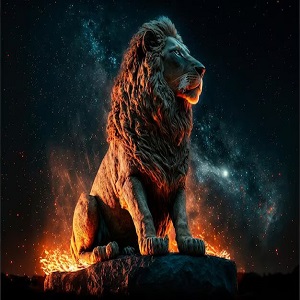In this content we are discussing 10 astonishing facts about Lions. The lion, scientifically known as Panthera Leo, stands as a symbol of regal strength and untamed majesty. With its commanding presence and powerful demeanor, the lion is often referred to as the “king of beasts.” This magnificent creature has captivated human imagination for centuries, drawing both reverence and fascination from cultures around the world. From the golden savannas of Africa to the pages of ancient mythology, the lion’s essence resonates deeply in our collective consciousness.
With its distinctive tawny coat and awe-inspiring roar, the lion occupies a special place in the animal kingdom. Beyond its physical attributes, the lion’s social structure and behavior have also earned it a unique standing among its carnivorous counterparts. Roaming the vast grasslands and brushlands of sub-Saharan Africa, the lion’s presence is not only a testament to nature’s creativity but also a reflection of the delicate balance that exists within ecosystems.
In this exploration, we embark on a journey into the heart of the lion’s world, delving into its habitat, habits, and the intricate threads that weave its existence into the tapestry of life on Earth. From the thunderous sound of its roar that carries across the plains to the profound lessons it offers about survival and community, the lion’s story is one that resonates with both its primal essence and the enduring connection between humans and the natural world. Join us as we unveil the captivating tale of the lion – a true embodiment of strength, courage, and the wild spirit of the wilderness.
Key points about lions!
- Physical Characteristics: Lions (Panthera Leo) are large, muscular big cats known for their distinctive appearance. Adult males typically have a luxurious mane of hair around their neck, which is absent in lionesses and younger males. They have a tawny coat, and their powerful build makes them one of the largest big cat species.
- Habitat and Distribution: Lions once roamed across much of Africa and parts of Asia, but their range has significantly decreased over time due to habitat loss and human encroachment.
- Hunting and Diet: Lions are carnivorous predators that mainly hunt large ungulates such as zebras, wildebeests, and buffalo. Lionesses are the primary hunters in the pride, using their teamwork and stealth to bring down prey.
- Roaring Communication: Lions are known for their distinctive roar, which can be heard from several miles away. Roaring helps lions communicate with each other, establish territory, and maintain social bonds within the pride.
- Conservation Status: Lions are listed as vulnerable on the International Union for Conservation of Nature (IUCN) Red List of Threatened Species. Their population has been declining due to factors like habitat loss, human-wildlife conflict, and poaching. Conservation efforts aim to protect lion habitats and ensure their survival.
- Cultural and Symbolic Significance: Lions have held cultural and symbolic significance in various societies for centuries. They are often associated with traits like bravery, strength, and leadership. In many cultures, the lion has been used as a symbol of royalty and power.
- Tourism and Ecotourism: Lions are a popular attraction for wildlife tourism in Africa. Many people travel to national parks and game reserves to see these majestic animals in their natural habitat, contributing to local economies and conservation efforts.
- Research and Study: Scientists study lions to better understand their behavior, ecology, and interactions with other species. Research helps inform conservation strategies and management plans to ensure the long-term survival of lion populations.
- Challenges and Future: Despite the challenges they face, efforts are being made to protect and conserve lions through habitat preservation, anti-poaching measures, and community engagement. Continued support and awareness are crucial to secure a future for these iconic big cats.
10 Astonishing Facts About Lion!
1. Roaring Majesty: Exploring the Fascinating World of Lions
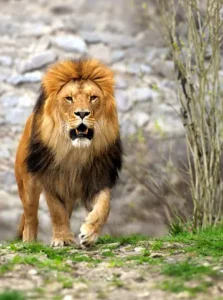
Step into the captivating realm of the lion, a majestic and iconic creature that has captured the hearts and imaginations of cultures throughout history. With its impressive physical stature, resounding roars, and powerful presence, the lion stands as a symbol of strength, courage, and regality.
Found primarily in the vast savannas and grasslands of Africa, lions live in social groups known as prides, where they exhibit intricate behavioral dynamics and hierarchical structures. These social units play a crucial role in the survival and success of the species, facilitating cooperation in hunting, protection of territory, and rearing of young cubs.
The lion’s striking appearance, characterized by its golden-brown fur, impressive mane (present in males), and keen, amber eyes, has inspired awe and reverence across cultures. Lions have been featured prominently in art, literature, and mythology, often representing traits such as nobility, leadership, and bravery.
In this exploration of the lion’s world, we delve into its remarkable adaptations, from its exceptional hunting prowess to its unique vocalizations that resonate across the African plains. We also uncover the challenges that lions face in the modern era, including habitat loss, human-wildlife conflict, and conservation efforts aimed at ensuring their continued existence.
2. The Lion’s Tale: Nature’s Regal Carnivore
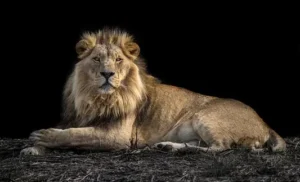
In the heart of the wild savannas and grasslands, a majestic and powerful figure reigns supreme – the lion. As a symbol of strength, courage, and regal elegance, the lion has captivated human imagination for centuries. This iconic carnivore, scientifically known as Panthera Leo, is not just a mere predator; it embodies a complex web of ecological significance, cultural symbolism, and a remarkable social structure.
Adorned with its distinctive golden mane, the male lion commands attention as the undisputed king of the animal kingdom. However, the lionesses play an equally vital role in this monarchic society, working together in synchronized harmony to ensure the survival of their pride. Their intricate social interactions, hunting strategies, and nurturing instincts reveal a profound interconnectedness that underscores the importance of cooperation in the wild.
Beyond its charismatic appearance, the lion plays a critical role in maintaining the ecological balance of its habitat. As a top predator, it helps control herbivore populations, preventing overgrazing and promoting the health of plant communities. The lion’s presence reverberates through the entire ecosystem, influencing the behavior of other species and shaping the very fabric of its environment.
Yet, the lion faces challenges that threaten its existence. Habitat loss, human-wildlife conflict, and poaching continue to diminish their numbers. Conservation efforts are essential to secure the future of this magnificent species and the ecosystems it inhabits.
“The Lion’s Tale: Nature’s Regal Carnivore” invites you to embark on a journey into the realm of these iconic creatures. Through exploration and understanding, we can unravel the intricacies of their lives, appreciate their role in the natural world, and work together to ensure the enduring legacy of the king of beasts.
3. In the Shadows of Savannas: The Mighty Lion’s Reign
Amidst the sprawling landscapes of savannas, an awe-inspiring ruler prowls in the shadows, exuding an unmatched aura of majesty and power—the lion. Inhabiting the heart of these vast grasslands, lions have established themselves as the undisputed monarchs of the wild, embodying both grace and ferocity in their every move.
With their iconic golden coats and impressive manes, male lions stand as symbols of strength and dominance, captivating both the imagination and the camera lens. Yet, it is within the intricately structured social fabric of lion prides that their true essence is revealed. Led by a formidable lioness, prides navigate the challenges of survival and hierarchy, offering a glimpse into the complexities of their existence.
The lions’ reign extends beyond mere physical prowess. Their resonating roars echo across the plains, a declaration of territorial sovereignty that reverberates through the ages. These vocalizations, along with their distinctive behaviors, serve as a language that shapes interactions within the pride and communicates their presence to rival groups.
As apex predators, lions play a crucial role in maintaining the ecological equilibrium of their habitat. Their hunting strategies, social dynamics, and interactions with fellow inhabitants interlace in a delicate dance that sustains the delicate balance of life on the savanna. Yet, these majestic creatures face challenges ranging from habitat loss to human conflict, underscoring the urgency of conservation efforts.
In the intricate tapestry of life on the savanna, the lion’s reign endures as an emblem of untamed beauty and resilience. Their story, etched across the landscapes they inhabit, serves as a reminder of the awe-inspiring force of nature and the need to safeguard their legacy for generations to come.
10 Important Types Of Rabbit
4. Lion: King of Beasts and Symbol of Strength
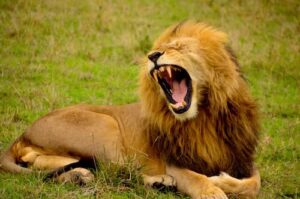
The lion, often hailed as the “King of Beasts,” holds an indomitable place in both the animal kingdom and human culture. Its majestic presence and regal demeanor have earned it this esteemed title, embodying strength, courage, and leadership.
With its powerful build and distinctive mane, the lion commands attention wherever it roams. This iconic mane, a symbol of maturity and virility, further accentuates the lion’s dominance and authority. In the wild, lions are unparalleled predators, adept at hunting large prey and working cooperatively in social groups known as prides.
Beyond its physical prowess, the lion has also become a universal symbol of strength. Throughout history, this majestic creature has been featured in art, literature, and mythology, representing traits such as bravery, nobility, and resilience. From ancient civilizations to modern times, the lion’s symbolism remains a testament to its enduring impact on human imagination.
In addition to its cultural significance, the lion plays a crucial role in maintaining the balance of ecosystems. As apex predators, they help regulate prey populations, ensuring the vitality of their habitats. However, the lion faces challenges such as habitat loss and human-wildlife conflicts, highlighting the importance of conservation efforts to safeguard its future.
In essence, the lion’s title as the “King of Beasts” goes beyond mere nomenclature; it encapsulates a rich tapestry of strength, symbolism, and ecological importance. As we continue to marvel at the lion’s magnificence, let us also strive to protect and preserve its rightful place in the natural world.
5. Untamed Royalty: The Captivating Life of Lions
In the heart of the wild, a majestic symbol of power and grace reigns supreme – the lion. With its regal presence and awe-inspiring roar, the lion stands as an emblem of untamed royalty in the animal kingdom. Roaming the savannas and grasslands of Africa, this iconic apex predator embodies both ferocity and familial bonds.
From the distinct outline of its magnificent mane to the mesmerizing gaze of its golden eyes, every aspect of the lion’s existence tells a story of survival and strength. These social creatures thrive in prides, displaying complex interactions that mirror human society in astonishing ways. The pride, led by a dominant male and comprising lionesses and their cubs, showcases a remarkable synergy that guarantees their place at the top of the food chain.
The captivating life of lions unveils a series of dynamic behaviors – from the strategic teamwork employed during hunts to the nurturing care bestowed upon the young. As skilled hunters, their stealth and precision in tracking prey are a testament to their exceptional hunting prowess. Beyond their raw power, lions reveal tender moments of bonding, grooming, and communal protection within their family units.
However, the lion’s kingdom faces threats and challenges, from habitat loss to human-wildlife conflicts. Conservation efforts are vital to ensure the perpetuation of their untamed royalty for generations to come. By delving into the captivating life of lions, we gain a deeper understanding of the delicate balance they maintain within their ecosystems and the profound impact they have on our planet’s biodiversity.
In “Untamed Royalty: The Captivating Life of Lions,” we embark on a journey to unravel the mysteries of these enigmatic creatures, celebrating their role as rulers of the wild while advocating for their preservation in a rapidly changing world.
6. Prowess and Pride: Unveiling the Secrets of Lions
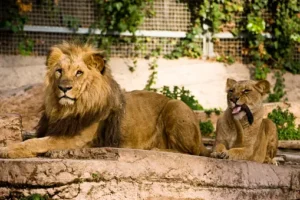
In the heart of untamed landscapes, where the sun-kissed savannas meet the rugged wilderness, a majestic predator reigns supreme—the lion. With its awe-inspiring presence and commanding roar, the lion has captured human imagination for centuries, symbolizing strength, courage, and regal authority.
Standing as the unrivaled monarch of the animal kingdom, lions exhibit remarkable prowess both in their hunting prowess and social dynamics. Their distinctive manes, ranging from blond to dark, adorn their powerful frames, embodying both grace and power. Meticulously designed by nature, these manes play a crucial role in asserting dominance and attracting potential mates.
Delving into the intricacies of lion society unveils a complex tapestry of relationships. Within the pride, an extended family unit, lionesses collaborate to hunt and raise their cubs, forming the backbone of the pride’s survival. Meanwhile, the male lions, or “kings,” defend their territories and protect their legacy.
But beyond the surface lies a world of hidden behaviors and survival strategies. Their distinct roles within the pride, the strategies employed for successful hunts, and the communication through a range of vocalizations and body language—these are the secrets that define the lion’s existence.
As the sun sets over the savanna and the night awakens, the lion’s prowess truly shines. Stealthy and strategic, they become formidable hunters under the moon’s gaze. Their ability to adapt to various environments, from grasslands to woodlands, showcases their resilience in the face of change.
“Prowess and Pride: Unveiling the Secrets of Lions” invites you to embark on a journey of discovery, shedding light on the intricate web of life woven by these remarkable creatures. Explore their world, from the raw savanna to the heart of their pride, and uncover the hidden threads that contribute to the lion’s enduring legacy in the wild.
7. Beyond the Mane: A Closer Look at the Enigmatic Lion
Inhabiting the vast savannas and grasslands of Africa, and even some parts of Asia, lions live in social groups known as prides, where a dominant male leads a group of lionesses and their offspring. This intricate social structure contributes to their survival and success as apex predators.
Underneath its iconic shaggy mane lies a hunter of remarkable prowess. Lions are finely tuned predators, relying on stealth, teamwork, and strategic hunting techniques to secure their meals. Their incredible speed and agility are often overshadowed by their reputation as fearless rulers of the animal kingdom.
While the lion’s roar can be heard from miles away, communication among pride members involves a repertoire of vocalizations, facial expressions, and body language. These forms of interaction reinforce bonds, establish hierarchy, and ensure the cohesion of the pride.
However, the enigma of the lion extends beyond its physical attributes and behaviors. Lions also hold cultural and spiritual significance for many societies, representing qualities ranging from courage and nobility to guardianship and symbolism in mythology.
In “Beyond the Mane: A Closer Look at the Enigmatic Lion,” we delve into the multifaceted world of this remarkable creature. By peering beyond its iconic appearance, we uncover the intricate dynamics of its social structure, the artistry of its hunting strategies, and the deeper meanings attributed to its presence in our shared human narrative. Join us on a journey that seeks to unravel the mysteries that surround the lion, revealing a deeper understanding of one of nature’s most iconic and enigmatic species.
30 Amazing Facts About Deer And Types
8. Lionhearted: Courage and Majesty in the World of Lions
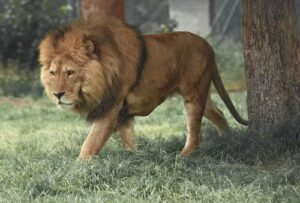
In the vast tapestry of the animal kingdom, few creatures command the same level of awe, respect, and fascination as the lion. Known as the “King of Beasts,” the lion is not merely a symbol of regal power, but a living embodiment of courage and majesty.
With a distinctive golden mane that radiates both strength and dignity, the lion has long captivated human imagination, weaving its way into ancient myths, cultural symbols, and modern conservation efforts. This apex predator, with its muscular physique and keen hunting instincts, holds a crucial role in maintaining the delicate balance of ecosystems, particularly within the savannas of Africa.
While their fearsome roars resonate across the grasslands, lions also exhibit a complex social structure, living in prides led by wise and protective matriarchs. Their interactions, from communal hunting to nurturing cubs, reveal a depth of intelligence and emotional connection that echoes our own understanding of family dynamics.
However, the lion’s realm is not without challenges. Habitat loss, human-wildlife conflict, and poaching threaten their existence, underscoring the importance of conservation efforts. Initiatives to safeguard these magnificent creatures serve as a testament to their enduring legacy and the shared responsibility we bear in preserving their habitats.
“Lionhearted: Courage and Majesty in the World of Lions” invites us to delve into the intricate world of these remarkable beings. Through their unwavering courage, innate majesty, and the ongoing battle for their survival, we are reminded of the profound interdependence between all living things on our planet. As we stand witness to the lion’s story, we are compelled to protect not just a species, but a symbol of the wild’s indomitable spirit.
9. Lions in the Wild: An Intimate Glimpse into Their Lives
Embarking on a journey into the heart of the untamed savannas, “Lions in the Wild: An Intimate Glimpse into Their Lives” offers a captivating exploration of one of nature’s most majestic creatures. The lion, known as the king of beasts, roams these expansive landscapes with an air of regal authority and a captivating mystique.
With their golden-hued coats and commanding presence, lions stand as a symbol of strength, courage, and unity within their prides. This fascinating study delves deep into the intricacies of their social structures, shedding light on the bonds that tie these incredible animals together. From the nurturing care of lionesses to the impressive manes of the males that signify maturity and dominance, every facet of their lives is examined with a keen eye.
Venturing beyond the surface, the documentary captures intimate moments rarely witnessed by human eyes. The thrill of the hunt, the tender interactions between cubs and their parents, and the echoing roars that pierce the stillness of the night – all unfold in vivid detail, painting a vivid portrait of their existence in the wild.
“Lions in the Wild” not only offers an educational insight into the behaviors and habitats of these iconic creatures but also raises important questions about their conservation in the face of evolving ecosystems and human encroachment. Through stunning visuals and expert commentary, viewers are invited to embark on a profound expedition into the realm of lions, gaining a newfound appreciation for their role in maintaining the delicate balance of the natural world.
10. Golden Eyes and Golden Rule: Understanding Lions in Their Habitat
Beyond their ferocious exterior lies a deeper understanding of the “Golden Rule” among lions. While they are fearsome predators, they maintain an ecological equilibrium by controlling herbivore populations, which in turn shapes the landscape. As apex predators, lions exert an influence that resonates throughout their habitat, emphasizing the vital interconnectedness of all living beings.
Through captivating insights and untold stories, “Golden Eyes and Golden Rule” offers an intimate glimpse into the lives of lions, shedding light on their behaviors, challenges, and contributions to their environment. Join us on a journey to comprehend the true essence of these regal creatures and the profound wisdom they impart about life in the untamed corners of our planet.
Conclusion:
In conclusion, the lion stands as an embodiment of nature’s grandeur and complexity. Beyond its majestic appearance, the lion’s intricate social structure, remarkable hunting prowess, and vital role in maintaining ecosystem balance underscore its significance.
As a symbol of strength, courage, and unity, the lion continues to captivate our imagination and remind us of the intricate web of life that sustains our planet. It is a testament to the intricate beauty of the natural world and a call to preserve and protect the delicate harmony of which it is an integral part. Through understanding and appreciating the lion, we gain insight into the delicate balance that exists in our shared biosphere and the importance of safeguarding the legacy of this magnificent creature for generations to come.
FAQ’s:
What’s the average lifetime of a captain in the wild?
A Lions in the wild generally live for around 10 to 14 times, while those in prison may reach up to 20 times due to reduced environmental challenges and access to medical care.
How does a captain’s roar help in communication?
A captain’s roar can be heard from several long hauls down and serves as a means of communication among pride members. Roaring helps establish home, communicate with distant pride members, and signal readiness for stalking.
Are Napoleons social creatures?
Yes, Napoleons are largely social brutes that live in family groups called prides. These prides correspond of affiliated ladies and their seed, working together to hunt, defend home, and hinder youthful cubs.
What’s unique about a captain’s stalking geste?
A Lions are known for their collaborative stalking strategy, frequently counting on cooperation to take down larger prey. womanish Napoleons primarily do the stalking, showcasing remarkable cooperation and coordinated sweats during hunts.
How do Napoleons contribute to ecosystem balance?
A Lions play a pivotal part in maintaining ecosystem balance by controlling critter populations. By keeping critter figures in check, Napoleons help overgrazing and help promote the health of foliage, which in turn supports other wildlife species.
Must Visit: Vetpomedix.com
